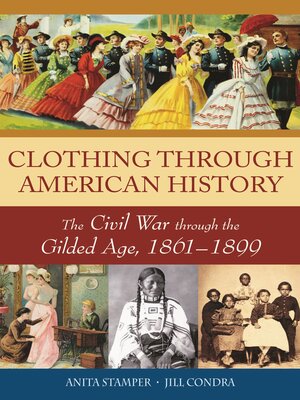Clothing through American History
ebook ∣ The Civil War through the Gilded Age, 1861–1899
By Anita Stamper

Sign up to save your library
With an OverDrive account, you can save your favorite libraries for at-a-glance information about availability. Find out more about OverDrive accounts.
Find this title in Libby, the library reading app by OverDrive.



Search for a digital library with this title
Title found at these libraries:
| Library Name | Distance |
|---|---|
| Loading... |
Learn what men, women, and children have worn—and why—in American history, from the deprivations of the Civil War through the prosperous 1890s.
In Clothing through American History: The Civil War through the Gilded Age, 1861–1899, authors Anita Stamper and Jill Condra provide information on fabrics, materials, and manufacturing; a discussion of daily life and dress; and the types of clothes worn by men, women, and children of all levels of society. The volume features numerous illustrations, helpful timelines, resource guides recommending Web sites, videos, and print publications, and extensive glossaries.
Among the many topics discussed include:
The hours that middle class women of the nineteenth century spent making clothes for themselves and their families
The plain, rough clothes assigned to slaves to ensure that they did not enhance their appearance and their later trouble in buying clothes after emancipation
The Bloomer dress reform movement in the mid to late 19th century, where women who adopted loose, baggy trousers for practicality were called evil and unnatural
The beginnings of clothing and department stores
In Clothing through American History: The Civil War through the Gilded Age, 1861–1899, authors Anita Stamper and Jill Condra provide information on fabrics, materials, and manufacturing; a discussion of daily life and dress; and the types of clothes worn by men, women, and children of all levels of society. The volume features numerous illustrations, helpful timelines, resource guides recommending Web sites, videos, and print publications, and extensive glossaries.
Among the many topics discussed include:







